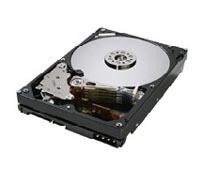Hitachi sees 5 TByte harddrives and 60 GByte microdrives
Tokyo - Hitachi believes perpendicular recording will allow harddrive engineers to take sub-1" microdrives to 60 GByte and desktop harddrives beyond a TByte. The company demonstrated the technology with a density of 230 Gbit per square inch which is about 70 percent more than in today's highest density production drives.
The natural barrier of harddrive density is near - this is what we have been hearing from the harddrive density for more than a decade. Now it appears that the good old Winchester technology, the 32-year old foundation of computer harddrives, may not be too close after all. Ten years ago, industry experts believed that a 100 GByte desktop drive may require for example laser assistance for data recording, Hitachi now believes to be able to take the drive beyond the TByte mark.
The concept to achieve this goal is based on perpendicular recording, which aligns data vertically to increase storage density. The basic idea of technology is almost 100 years old and most recently was discussed also by Hitachi's competitors such as Seagate. Hitachi now claims that it can lift storage density to 230 Gbit per square inch, which is significantly higher than the 133 Gbit per square inch offered for example in Toshiba's 1.8" harddrives. Hitachi said it achieved the 230 Gbit per square inch density by manipulating the head and media so that the distance between them is a mere 10 nanometers or 1/10,000th of a human hair.
Perpendicular recording is consider one solution to maintain data integrity at tight areal densities. The technology can produce higher magnetic fields in the recording medium, provides manufacturers with a way to keep magnetized bits from influencing each other and keep magnetic fields stable to avoid data loss. Seagate believes that the limit of longitudinal recording may be reached sometime before 200 Gbit per square inch. Perpendicular recording could take the industry all the way to about one Tbit per square inch, said Mark Kryder, Chief Technology of Officer of Seagate, in an earlier conversation with Tom's Hardware Guide. TeraByte harddrives are expected to arrive by 2007.
According to Hitachi, the potential of perpendicular recording will be realized over the next five to seven years.
Related stories
Seagate eyes TeraByte harddrive platters by 2010
Get Tom's Hardware's best news and in-depth reviews, straight to your inbox.

Wolfgang Gruener is an experienced professional in digital strategy and content, specializing in web strategy, content architecture, user experience, and applying AI in content operations within the insurtech industry. His previous roles include Director, Digital Strategy and Content Experience at American Eagle, Managing Editor at TG Daily, and contributing to publications like Tom's Guide and Tom's Hardware.
